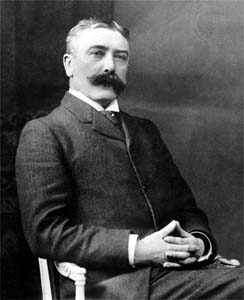Ferdinand de Saussure
From Geography
Ferdinand de Saussure was a Swiss linguist. He was born in 1857 in Geneva, and died in 1913. Much of De Saussure's thinking connects to the constructionist approach. He has made very important contributions to the linguistic studies, therefore he is called ´father of the modern linguistics´ (Hall, 1997, p. 30). He rejected the view of traditional linguistics because he disagreed with their opinion that 'words are symbols standing for objects in the world'. Instead he saw language as a system of signs. Thereby De Saussure introduced a new way of looking at representation and signs. He said that words are a kind of sign, created by the relation between the signifier (visual image, a physical sign) and the signified (concept behind the image). His formulation and view were quite pioneering, because his ideas were that the meaning of something is created in a complex social structure of relation and difference (Gibson-Graham, 2000, p. 96). Saussure stated that a language consists of signifiers, but in order to produce meaning, the signifiers have to be organized in 'a system of differences'. It is the differences between signifiers which signify (Hall, 1997, p. 32). An example given by Hall (1997) is the following: the colour red is not the essence of the signified. It is the difference between red and (for instance) green that signifies: it is not red itself that gives the meaning, but it is the relation with other colours.
Also, in different cultures and at different historical moments, the relation between the signifier and the signified is different. The relation signifier-signified is founded by interaction between different people. This shows that the signifier-signified relation is not a natural or inevitable link. Words and objects mean different things to different people, this shows that the relation signifier-signified changes. It is not a permanently fixed relation: words change their meaning and concepts (signifieds) change historically and depening on culture (Hall, 1997, p.32).
Related to this, De Saussure distinguishes la langue and la parole to emphasize the existance of a social and an individual aspect of language. Saussure sees language as a structure without positive terms. While parole is actually an individual speech act. It is how language is practiced by a community of speakers (Smith, 2009).
Due to his work, semiotics in the 19th century emerged as a method of examining phenomena in different fields. Barthes was inspired by De Saussure. Barthes looked at the meaning of texts. He didn't try to look at the meaning of texts by a scientific analyses (language's rules and laws) (Hall, 1997, p.42).
Critique
Poststructuralist thinkers did not agree with Saussurian linguistics on the fixed relationship between signifier and signified. Language does not exist as a system of differences among a single set of signs as Saussure argued. The creation of meaning (signified) is an ungoing and never ending process. For example: the political struggles undertaken by feminists can be seen as new creations of the meaning 'woman' (Gibson-Graham, J.K., 2000, p. 96).
References
- Hall, S. (1997). Representation: cultural representations and signifying practices. London: Sage Publications.
- Gibson-Graham, J.K. (2000). Poststructuralist interventions. In, E. Sheppard & T. Barnes (eds.) A companion to Economic Geography. Blackwell, Oxford, pp. 95-110.
- Smith, R.G. (2009). Structuralism/Structuralist Geography. In:International encyclopedia for Human Geography. Elsevier
Contributors
- Created by Boudewijn Idema, 10 september 2011
- Edited by Jobke Heij, 10 september 2011
- Enhanced by --AafkeBrus 10:39, 12 September 2011 (UTC)
- Edited and improved by Lars-Olof Haverkort --LarsHaverkort 19:56, 24 September 2012 (CEST)
- Edited by --HennyLi 14:41, 15 October 2012 (CEST)
- Edited by Niek van Enckevort, 25-10-2012
- Picture added by --AnneStrien 12:28, 26 October 2012 (CEST)
